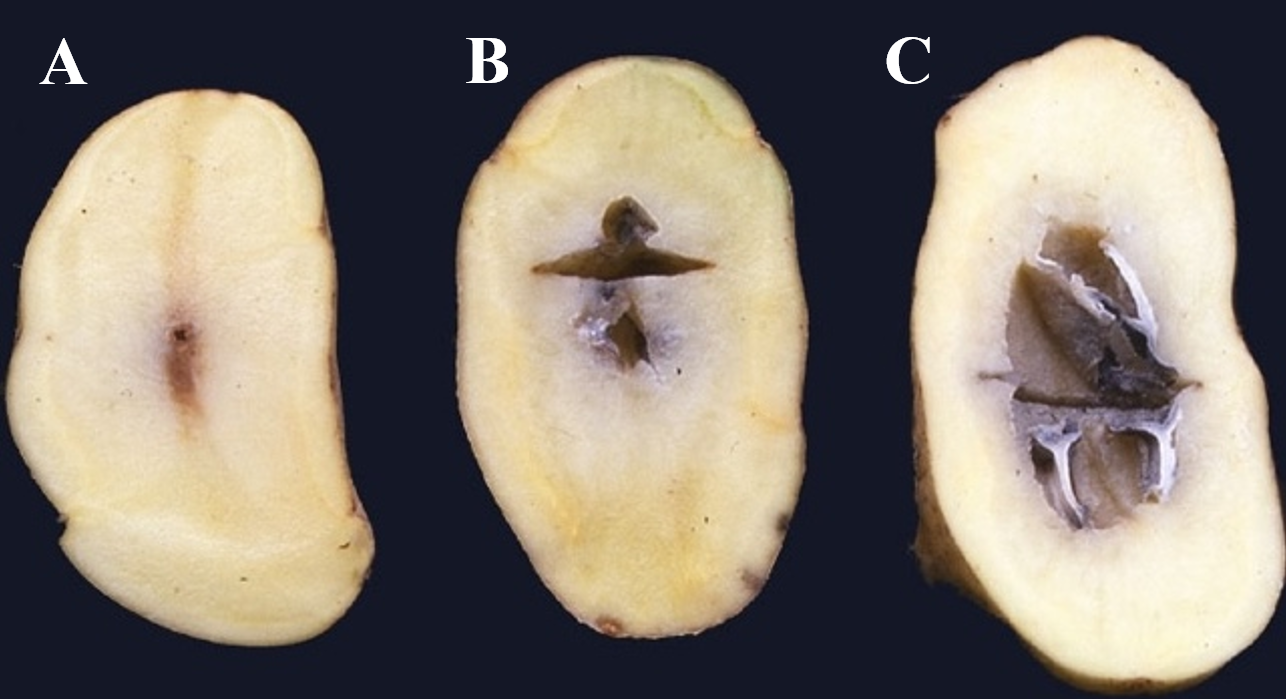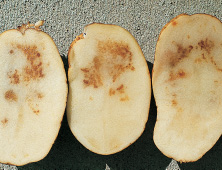Written by Yi Wang, Associate Professor & Extension Potato and Vegetable Production Specialist, UW-Madison, Dept. of Plant and Agroecosystem Sciences, 608-265-4781, Email: wang52@wisc.edu.
Hollow heart

Hollow heart (above), depending on its severity, is also called brown center. Brown center is a milder form of hollow heart. A brown discoloration without a visible flesh separation in the pith region of the tuber is known as brown center (a). The brown coloration results from inadequate mineral and carbohydrate concentrations in the affected tissues that reduce cell membrane integrity. Tubers are mostly susceptible to brown center during the period from tuber initiation through early tuber bulking. Soil temperatures below 55°F for 5 to 7 days during early tuber development can initiate brown center.
Available soil moisture levels above 80 to 85% during early tuber bulking can also increase the incidence of brown center, possibly due to the slower warming of wet soils.
Hollow heart (b, c) is characterized by the formation of an irregular cavity in the flesh of the tuber, usually surrounded by dark brown tissues. The cavities can vary widely in size and can form in the center of the pith or near the stem or bud ends of the tuber, depending on when the disorder occurs.
There are two types of hollow heart, namely early and late initiation types. Early initiation appears shortly after tuber set and is caused by the same factors that cause brown center. Rapid tuber bulking results in the cavitation of the damaged tissues, which is often associated with a period of restricted tuber growth caused by cool soil temperatures, followed by accelerated growth rates as the temperature warms up. Excessive nitrogen availability during tuber initiation may increase the incidence of early initiation hollow heart by producing a large canopy that competes with tubers for nutrients and carbohydrates, and by cooling the soil through shading of the soil surface.
Late initiation hollow heart occurs during the latter part of the tuber bulking period and is not usually associated with a brown center. It is most commonly caused by a growth stop due to soil moisture or temperature stresses, followed by a return of favorable conditions and rapid tuber growth. In this process, cell division resumes but follows a different direction, causing the tuber interior to split and an internal gap to form.
Previous data show that before row closure, nitrogen fertilization rates above 200 lb/acre and available soil moisture above 80-85% field capacity (FC) can significantly increase the incidence of brown center and hollow heart. Therefore, during the early season, smaller dose of nitrogen applications and keeping the soil moisture between 65 and 80% FC are good to reduce brown center and hollow heart. Calcium application is also helpful in providing the cell walls with strength and rigidity, and reducing these defects. During the later season, informed irrigation and fertility management are generally good.
Brown center and hollow heart will NOT occur after vine kill, because vine kill stops tuber growth.
Heat necrosis

Heat necrosis is also referred to as internal brown and internal necrosis, which is characterized by small, brown, necrotic lesions or spots inside the vascular ring of the tuber (Figure on the left). It should be noted that heat necrosis differs from brown center in that it does not concentrate in the pith of the tuber, but instead appears as diffuse spots randomly distributed in the tuber flesh. Heat necrosis could begin to develop shortly after tuber initiation. But more commonly, it becomes more severe during late tuber bulking and senescence, or even after vine kill. Symptoms also tend to intensify during storage under warm temperatures. Research has found a relationship between the development of this defect and a lack of adequate calcium in the tuber. Hot, dry weather and high soil temperatures and fluctuating soil moisture conditions during tuber bulking are also associated with the incidence and severity of heat necrosis. In sandy soils that have low cation exchange capacities and higher conductance of heat, it can be more prevalent. Some varieties, such as Atlantic, Yukon Gold, and Russet Burbank, are susceptible to heat necrosis.
Supplying sufficient irrigation during hot and dry periods is helpful to reduce heat necrosis. Adequate calcium in the tuber-forming zone in the sandy soil or low calcium soil is also a good cultural practice to prevent this defect.